Content
- 1 The best varieties of yellow plums and their description
- 2 Early ripe
- 3 Mid-season
- 4 Late ripening
- 5 What varieties of plums are best for the Moscow region
- 6 Common features of yellow plum species
- 7 Description of early ripe varieties of yellow plum
- 8 Mid-season varieties of yellow plum
- 9 Late-ripening varieties of yellow plum
- 10 Yellow plum care
- 11 Plum varieties for the Moscow region and the middle zone
- 12 Early varieties of plums
- 13 Self-fertile varieties of plums
- 14 Large-fruited varieties of plums
Delicious, juicy plum - one of the favorite trees in the summer cottage, but also quite whimsical to care for. But the result is worth it, in addition, you can choose a variety with your favorite taste.
And in order for the harvest to be generous, you need to choose a seedling that is suitable for your region of growth.
Consider the best and the most popular varieties of plums... After all, in order to choose the right tree, it is worth knowing its characteristics.
The best varieties of yellow plums and their description
Due to their bright golden color and interesting honey taste, they seem to be the most attractive for growing. Below we describe those that are most famous and in demand.
Morning
Self-fertile variety, medium-sized, first harvest in the sixth year after planting. The parents of the variety are Renklod Ullensa and Skorospelka red, as a result of crossing which the Morning plum was obtained.
The fruits are harvested in early August., on average, 15-20 kg of plums are harvested from a tree.
The fruits are round, rather large, yellow with a greenish tint, may turn pink in the sun.
The plum has a yellow, moderately juicy and tough pulp, not too honey, with a characteristic sourness due to the considerable presence of ascorbic acid.
The variety is not too resistant to attacks of such pests as aphids and moths, there is no immunity to fruit rot, average frost resistance.
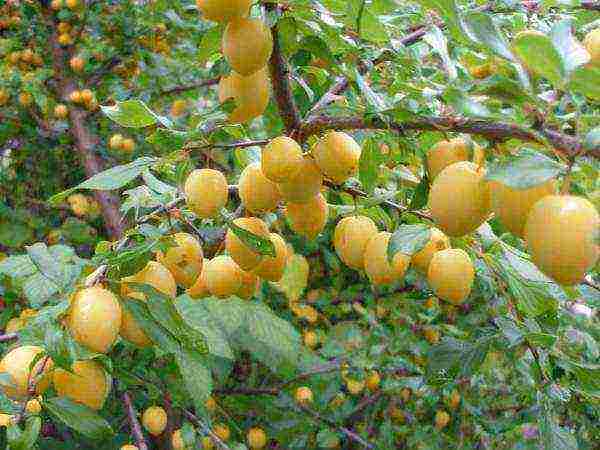 Plum variety Morning self-fertile, large fruits, average frost resistance
Plum variety Morning self-fertile, large fruits, average frost resistance
Tatar yellow
Bred by free pollination of the yellow Renklod variety. Medium tree of medium frost resistance, poorly resists pests and diseases, which is a disadvantage of the variety.
Pollination with other varieties is necessary, since the described one is not self-fertile.
Harvested at the end of summer... The fruits of this variety are medium in size, with a bright honey-yellow color. They are juicy, with grainy, sweet-sourish pulp.
Early Loshchinskaya
A variety with high frost resistancetherefore it is suitable for growing even in very cold climates. Not self-fertile, so other plums are needed for pollination.
The tree begins to bear fruit already five years after planting, in the best fruitful years, allowing to collect about 30 kg of plums from each.
The fruits are large, moderately soft, the stone separates well, pleasant honey aroma and taste. Plums are yellow with a greenish tinge, sometimes with a blush.
They give an early harvest, and the fruits are able to stay on ripe branches for a rather long time, without falling off.
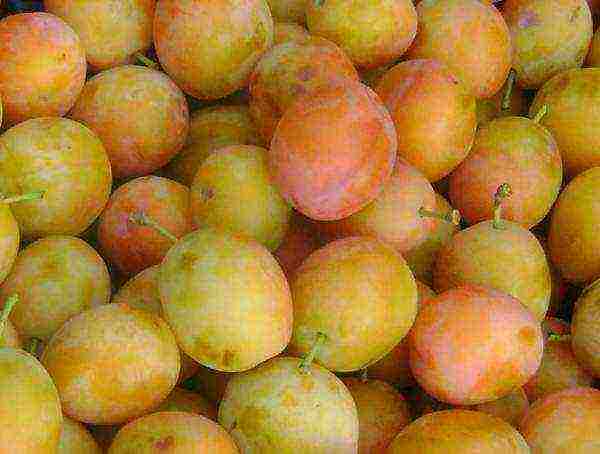 Plum variety Early Loshchinskaya is suitable for growing even in very cold climates, not self-fertile
Plum variety Early Loshchinskaya is suitable for growing even in very cold climates, not self-fertile
White honey
One of the earliest varieties of yellow plum, the harvest begins to take off in late July - early August. Other pollinated trees are needed, the most suitable are Renklode and Hungarian Rannyaya.
The tree is tall with a rounded, not very thickened crown, which is most favorable for fast and uniform ripening of fruits.
Plums taste like real honey, thanks to which the variety got its name. The fruits themselves are large, sometimes of uneven size in one crop, round in shape with a dense yellow skin.
Plums of this variety tolerate transportation very well., have good commercial qualities. They are characterized by the presence of a rich yellow pulp.
Juicy, very sweet with a moderately sour aftertaste. Due to its structural density, the pulp does not separate well from the stone.
White honey is unpretentious to the growing area, high-yielding, tolerates well even the most severe frosts. It takes root in any climatic zone.
Early ripe
The early varieties of plums are those the harvest of which begins to be harvested from the end of July... Let's consider the most popular ones.
July
Medium-sized tree with not too thick crown, harvested by the end of July. The variety is distinguished by large fruits. red in color with a violet tinge of an oval, elongated shape. The flesh of the plums is yellow, firm, very sweet.
After landing begins to bear fruit in the third year, from one plum, about 12 kg of the crop can be removed. Grows well in sunny areas with moderate humidity. Eaten fresh or canned.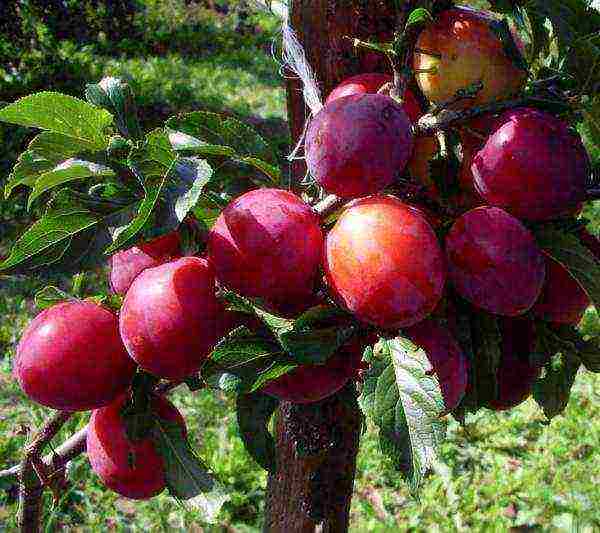 Plum of the Julskaya variety bears fruit in the third year after planting, the fruits are large, very sweet
Plum of the Julskaya variety bears fruit in the third year after planting, the fruits are large, very sweet
Zarechnaya early
High-yielding variety, fruiting is regular from 3-4 years. From one tree, you can regularly remove up to 15 kg of dark purple large fruits.
Plums have a waxy coating, yellow sweet pulp with a pronounced sour taste, well separated from the stone.
The variety is winter hardiness... Zarechnaya plums are eaten fresh or canned.
Golden ball
High yielding variety, one of the best among yellow plums. The first crop is harvested already 3-4 years after planting the seedling.
Especially appreciated for its large yellow fruits with an original aftertaste of peach and pineapple, golden yellow color.
A distinctive feature is the arrangement of the fruits on the branches, they seem to stick around them.
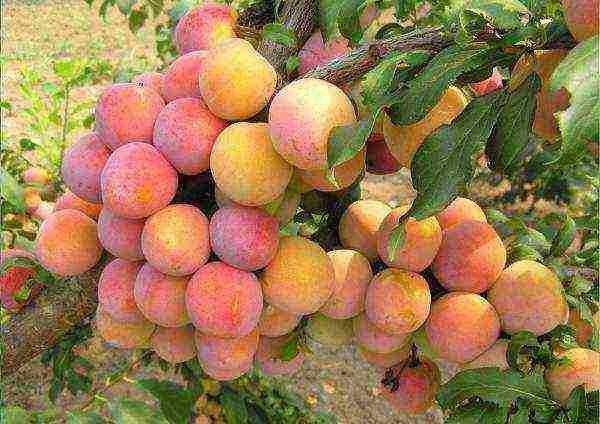 Plum variety Golden ball high-yielding, fruits with an original flavor of peach and pineapple
Plum variety Golden ball high-yielding, fruits with an original flavor of peach and pineapple
Early
Winter hardy variety, the first crop is harvested after 2-4 years, starting at the end of July. Plums are medium-sized, red, with juicy, moderately sweet, aromatic pulp.
The variety is considered dessert, well transported. Up to 10 kg of the crop is harvested from one tree.
Mid-season
One of the best varieties of mid-ripening plums include Souvenir of the East and Romain.
Souvenir of the East
The tree of this variety has a spreading crown, reaching 3 m in height. Large rounded plums, when ripe they turn orange. Overripe fruits acquire a burgundy color.
The pulp is orange-yellow, characterized by juiciness and dense texture, crispy.
Plums have a sweet, spicy flavor with sourness and a pronounced aroma reminiscent of a peach. The fruit has a small stone, practically does not separate, therefore it is preferable to use fresh plums of the Souvenir of the East variety.
When making compotes, the fruits disintegrate and boil down, therefore it is good to cook jams and juices with pulp.
The variety is highly frost-resistant, characterized by abundant spring flowering., plum-pollinators are needed. The harvest of fruits from one tree, formed in a bunch, is harvested up to 40-45 kg.
The variety is susceptible to perforated spotting, clasterosporium disease, hard to endure winter-spring thaws.
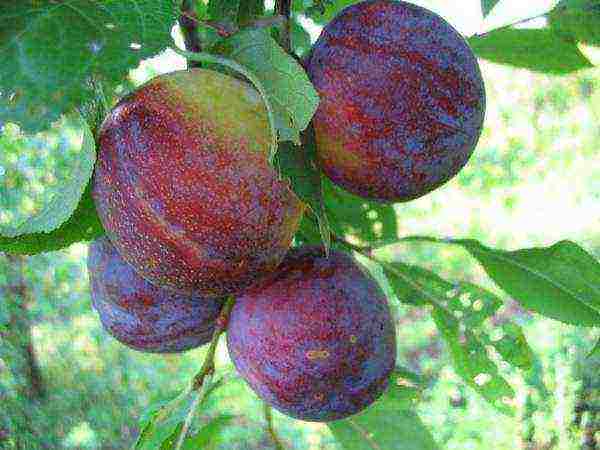 Plum variety Souvenir of the East is highly frost-resistant, fruits are preferable to use fresh
Plum variety Souvenir of the East is highly frost-resistant, fruits are preferable to use fresh
Romain
A distinctive feature of the Romaine plum is red leaves and pulp, originated from the Krasnomyasaya variety. The crown is small, the fruits are rather small in the shape of a heart, burgundy in color, with a characteristic taste of almonds.
Late ripening
Plums of this category bloom from mid-May, and the harvest is removed by the end of September.
Renklode Michurinsky
The tree of this variety is characterized by a medium thickened rounded crown. The first harvest gives in 3 years with large, regular-shaped fruits, purple-red in color.
The pulp is very juicy, tender, orange in color, with a pleasant sour taste.
The juice from Renclode plums is colorless. The stone is well separated, suitable for preservation. Variety well transported and stored in the refrigerator.
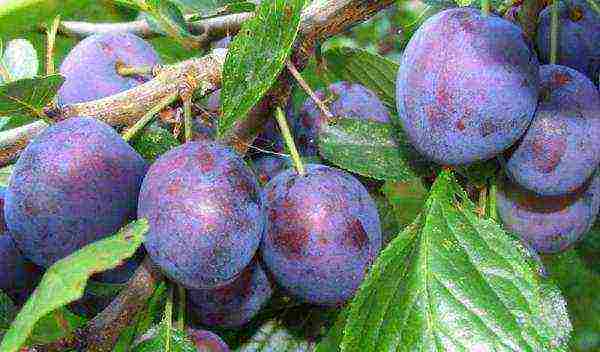 Plum of the Renclode Michurinsky variety is well suited for conservation, excellent transport and storage
Plum of the Renclode Michurinsky variety is well suited for conservation, excellent transport and storage
Svetlana
High yielding variety, more than 40 kg of fruits are removed from one plant. Plums are yellow, elongated, of irregular elongated shape, medium size.
The pulp is light yellow in color, crispy and firm, sweet and sour, with a hard skin and a small bone that is poorly separated.
Begins to bear fruit after 3-4 years, is characterized by high resistance to frost, medium - to clotterosporia and rubella. Has no immunity to moniliosis.
Fruits are suitable for processing and consumption freshare well transported.
What varieties of plums are best for the Moscow region
Almost all of the above varieties of plums suitable for growing in the Moscow region... The following varieties are also suitable for growing in the Moscow region.
Yakhontova
In addition to high frost resistance, the variety tolerates well repeated spring frosts, which are often the culprits of crop failure during the flowering period.
Fruiting is abundant and regular, the yield from one tree reaches 50 kg.
Plums are bright yellow, have a good sweet and sour taste, pleasant aroma.
The tree grows up to 5 m tall, tolerates drought well, is resistant to fungal and viral diseases.
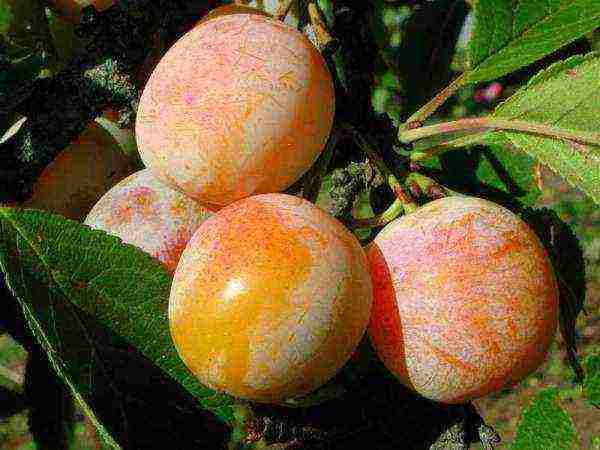 Plum Yakhontovaya perfectly tolerates frost and drought, is resistant to fungal and viral diseases
Plum Yakhontovaya perfectly tolerates frost and drought, is resistant to fungal and viral diseases
Russian plum
Or cherry plum hybrid grows in almost all gardens of the Moscow region. This is a hybrid variety of cherry plum, obtained by crossing it with the Ussuri plum, due to which the variety has acquired sufficient frost resistance.
From common cherry plum also differs in moderately large fruits with juicy pulp.
Gold of the Scythians
A kind of cherry plum obtained by breeding from the plum Kuban Comet.
A tree of medium height with a spreading crown. Fruits are bright yellow in color, rather large in size, with a strongly pronounced plum aroma and delicate taste.
Hungarian Bogatyrskaya
Plum late ripening, fruits are removed in September. Good frost tolerance, high-yielding variety.
From one tree, from 50 to 70 kg of purple oval-shaped plums are harvested, having a bright aroma, sweet honey taste.
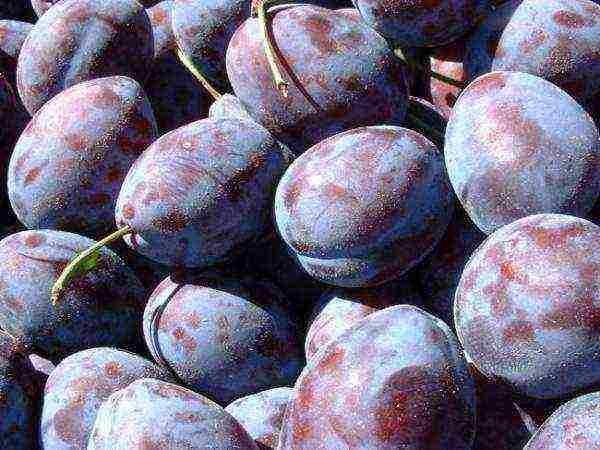 High-yielding plum variety Vengerka Bogatyrskaya tolerates frosts well
High-yielding plum variety Vengerka Bogatyrskaya tolerates frosts well
Traveler
The variety is frost-resistant, has immunity to viral and fungal diseases. It is better to choose a sunny place for planting. A bountiful harvest filming at the end of July.
Fruits are yellow with a purple barrel, orange pulp. The most suitable variety for making jam.
We have described the best varieties of plums, from which each summer resident can choose a variety that suits him, focusing on taste, resistance to diseases and frosts, as well as other criteria.
When choosing a place for planting a seedling, give preference to well-lit and places that are not too windy.
In Russian gardens, the yellow variety of plum is rarely found, and people far from plant growing are often mistaken for cherry plum. There is some truth in this delusion. Many varieties of yellow-fruited plums are, in fact, related to cherry plums.
They belong to the group of mirabelles, which are extremely popular in France. Some yellow varieties (with a greenish tinge) belong to the Renklode subspecies. Some come from the Chinese plum. In this article, we will consider a description of different varieties of plums: small and large. And also we will find out what the different species are called.
Common features of yellow plum species
Most often, plants of this group have round fruits. Rounded-oblong are less common. The main color is, of course, yellow, although some varieties may have a slight blush or green tint. The yellow plum variety tastes sweet, very juicy. Often small in size.
Regardless of the type, all yellow plums are united by a characteristic feature - self-sterility. Very rarely, among them, there are varieties with partial self-fertility. This is due to the fact that yellow-fruited plums are a product of selection; they are not found in wild forms. However, self-sterility also has a downside: in the presence of a suitable pollinator, such plums are capable of producing a grand harvest.
Like blue plums, yellow plums differ in their early maturity. This characteristic determines which pollinator to choose. For early varieties, for example, the old Skorospelka early variety is suitable. Mid-season - July. Late - Moscow Hungarian.
Description of early ripe varieties of yellow plum
As a rule, yellow-fruited plums of early ripening can be removed at the end of July or in August. These are varieties of universal use. They are consumed fresh, processed into juices, jams and pastilles.
Early plum yellow ball
A small plum with an amazing taste that reminds someone of a pineapple, someone of a peach. The variety is also found under the name Golden Ball. It is easy to distinguish it from others: during the ripening period, the branches of the spreading tree are strewn with round yellow fruits, tightly sitting on short petioles, like sea buckthorn berries. This is not surprising, since the Yellow Ball belongs to the subspecies of the Chinese plum.
The Chinese plum is characterized by a very early and exuberant flowering. Each flower bud produces 3 or 4 flowers. The Yellow Ball differs from other plants in this group by its higher growth: the tree can reach 5 meters. However, the main parental traits are inherited by the variety:
- frost resistance (up to -50⁰С);
- early maturity (begins to bear fruit in the 3rd year);
- excellent keeping quality due to the dense skin;
- high portability;
- resistance to major stone fruit diseases;
- low drought resistance;
- tendency to podperevaniya root collar.
The yellow ball is a very fruitful variety. And since the weight of each fruit can reach 60 grams, increased attention is required from the gardener. It may be necessary in some years to thin out the fruit or set up supports to keep the branches from breaking.
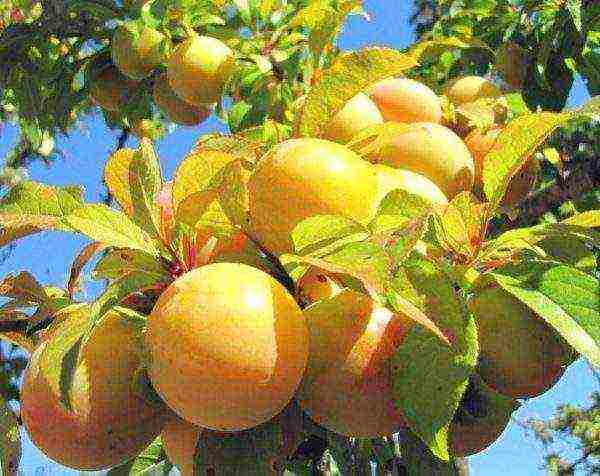 Plum variety Yellow ball
Plum variety Yellow ball
Small plum Altai jubilee
This variety also has a Chinese ancestor - the Manchurian prune plum. Thanks to this, the Altai Jubilee is able to withstand the harsh conditions of the Urals and Siberia. The color of its fruits is twofold: the main color is yellow, the integumentary color from the sunny side is red, with a protective waxy coating.
It is a medium-sized tree with a low stem and a back-pyramidal habit. The plum is small-fruited (only 14-16 grams each), but the taste of the fruit is very harmonious, with some sourness.
Altai anniversary self-sterile plum, but it can be safely planted next to other varieties, - she herself is an excellent pollinator. Its yield is high, although irregular. It begins to bear fruit in the 3rd year of life.
Unfortunately, like all "Chinese women", Altai Jubilee is not too resistant to damping, and it is risky to grow it in the middle lane. But this variety rarely suffers from perforated spotting.
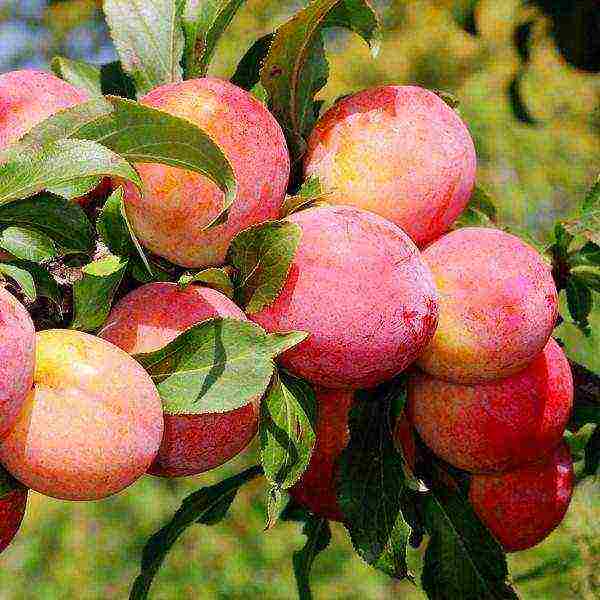 Plum Altai jubilee
Plum Altai jubilee
Round grade - Yantarnaya Mlievskaya
It is a thermophilic large-fruited variety bred by Ukrainian breeders at the Lev Platonovich Simirenko Institute of Pomology. According to some estimates, Yantarnaya is the best variety for making plum jam, because when overripe, the pectin content in fruits becomes very high.
The bright yellow fruits are oval in shape and can weigh up to 70 grams. The taste is very sweet, with a slight grape tinge. The pulp is juicy, with fibers, the stone separates well.
The peel on the fruit is thin, therefore, when fully ripe, they are poorly stored. However, Amber can be removed unripe - it lies in the refrigerator for a long time and is perfectly ripened.
The tree itself is medium-sized, with a compact crown, early-growing. Begins to bear fruit in the second year after planting. With a pollinator, up to 50 kg of fruit can be removed from one adult tree.
The winter hardiness of this variety is average. Regions with the harsh climate of Yantarnaya are not suitable. But in areas with mild winters, she does well. The main advantages of the variety: drought resistance and low susceptibility to stone fruit diseases.
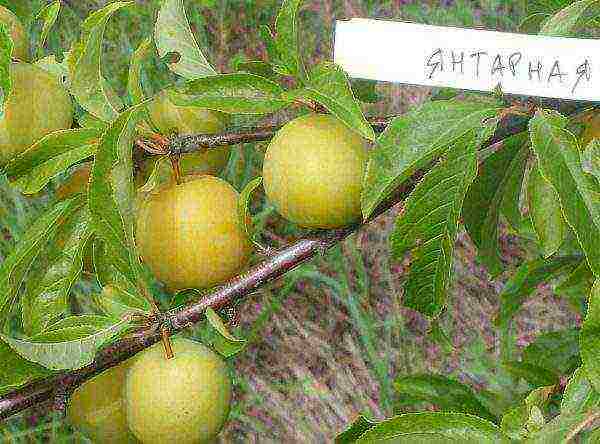 Amber variety of plum
Amber variety of plum
Honey
Honey white (aka Honey yellow) was bred by the Donetsk breeder L.I. Taranenko. The variety is also thermophilic, in Russia it is zoned in the Central Black Earth Region. However, the experience of gardeners shows that Honey, grafted onto a frost-resistant stock, bears fruit successfully and further north - in the Moscow region, Belarus, in the Kaliningrad region.
Plum Honey belongs to tall varieties. The tree can grow up to 6 meters. The fruits are oval, with a transparent yellow skin, waxy, reaching a weight of 50 grams. From the illuminated side, an orange integumentary color sometimes appears on them. The pulp is slightly greenish to intense yellow, depending on the degree of ripeness. Honey's taste is bright, sweet with a subtle sourness and honey aroma. The stone sits tightly, but in ripe fruits it separates well.
With good care, the cultivar shows excellent disease resistance.
Additional advantages are drought resistance, good keeping quality and transportability of fruits. Medovaya tolerates frosts of the middle zone perfectly, flower buds do not freeze.
Of the relative, completely surmountable disadvantages, only self-sterility and high growth of the variety can be noted.
Tall plums require close attention to regulating their growth. If you allow them to grow freely and do not prune the tree, after a few years, fruiting on the lower tier of the branches will fade away.
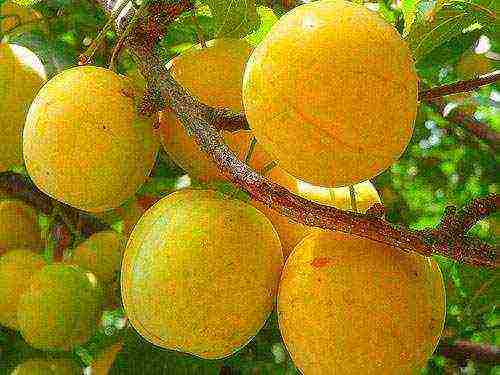 Plum variety Honey
Plum variety Honey
Mid-season varieties of yellow plum
Mid-ripening plums reach harvest maturity from late August to mid-September.
Ochakovskaya white
Just like Honey, this plum is sometimes called white or yellow, thanks to the waxy coating on the fruits. Ochakovskaya plum is easy to distinguish from others during flowering - by its large double flowers.
This is an old Russian variety, suitable for central Russia. The tree is medium-sized, up to 4 meters in height, with a tendency to thicken the crown, therefore it requires vigilant care for its formation.
The fruits of Ochakovskaya are oval, with a poorly discernible seam, of a greenish-yellow hue. The taste is very pleasant: sweet, with a note of spice, the pulp is juicy. The bone, like that of Medova, is semi-lagging.
Unfortunately, with the high quality of the fruit, this variety has many disadvantages:
- low ratio of the number of flower and vegetative buds (8: 100), which is why Ochakovskaya gives very modest yields;
- flower buds are poorly resistant to freezing;
- irregular fruiting;
- general low winter hardiness;
- the tendency of the fruit to crack and shedding.
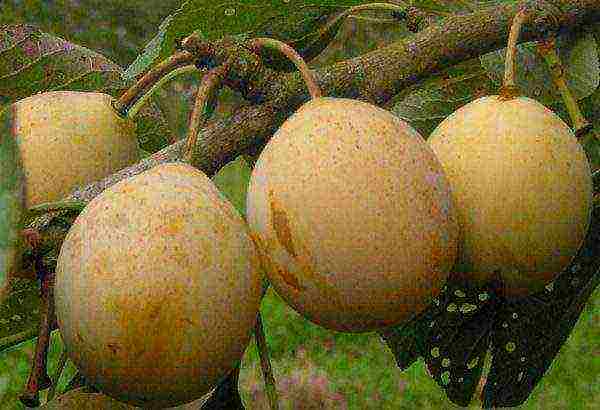 Homemade plum variety "Ochakovskaya yellow"
Homemade plum variety "Ochakovskaya yellow"
Compote
This variety of yellow plum was bred by the Russian breeder A. Velyaminov. Compote plum is remarkable in that it has not a tree-like, but a bush form. The bush grows high enough, up to 3 meters. The crown is spreading, the branches are raised.
Compote is a small-fruited variety. The fruits are round, with a dense bright yellow skin, weighing only 15 grams, reminiscent of cherry plum. The pulp is loose, juicy, sweet and sour taste. The name itself speaks of the purpose of the variety.
This small plant gives relatively good and stable yields: 15-20 kg of plums per bush. The advantages of the variety include its high frost resistance.
A tree-like form can be found in nurseries under the name "Compote yellow". In taste and color, the fruits of this variety are very similar to the bush, however, they are larger in size - up to 30 grams.
Late-ripening varieties of yellow plum
The ripening dates for the fruits of late-ripening plums are from mid-September to October.
Golden large
Heat-loving variety, Recommended by the State Register for the Lower Volga region. In severe frosts, shoots are damaged and one-two-year-old wood freezes.
Golden large differs from other yellow-fruited plums by partial self-fertility. The main advantage of the variety is large (more than 40 grams), excellent-tasting fruits, light yellow, with a slight blush, delicate edging and waxy bloom. They are able to ripen in the refrigerator and not lose quality in 1.5 months of storage.
The tree of this variety is medium-sized, with a pyramidal crown, begins to bear fruit in the 4th year. Yields are not record-breaking (about 30 kg per tree), but stable, without periodicity.
Other pluses of the Golden Coarse are high resistance to heat, drought and disease.
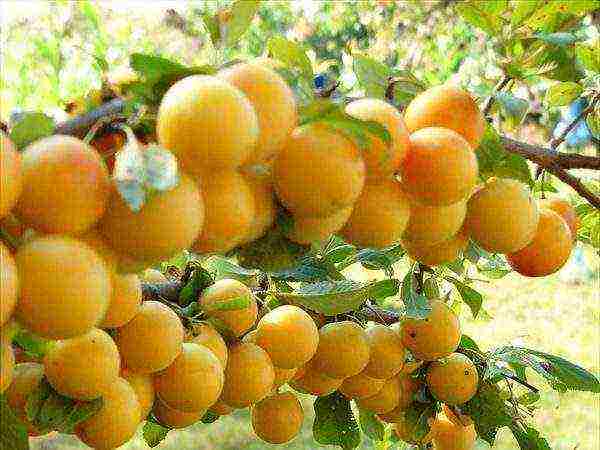 Golden plum
Golden plum
Yellow afasca
A very promising Bulgarian variety with exceptionally large fruits (60-70 grams). The fruits have an excellent dessert taste and an interesting color - yellow, with light greens. The yellow afasca is self-fertile, and the American plum Amers is best suited for pollination.
Another advantage of the Yellow Afasca is its early maturity. The variety can bring the first harvest already in the 2nd year. The plant is vigorous, with high winter hardiness and shark resistance. It is also susceptible to other diseases of stone fruits.
Among the disadvantages of the variety can be called the poor keeping quality of the fruits and their ability to quickly overripe on the tree. You only need to collect the Yellow Afasca manually.
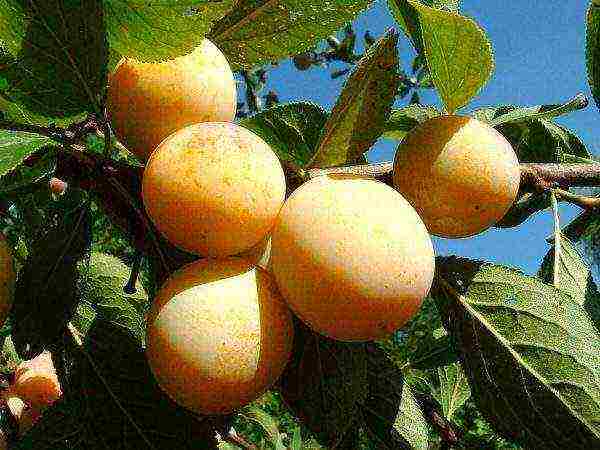 Yellow afasca
Yellow afasca
Egg yellow
A rare, ancient variety, first described in 1676. Like many old varieties of plum, it has many disadvantages, but may be of interest to collectors.
Egg yellow fruits are rather large, but have a mediocre taste and are sour. Purpose - for processing into compotes, marshmallows. The skin color is bright yellow, the stone is inseparable. Fresh fruits begin to deteriorate after a week of storage.
The plant itself is vigorous, with a round sparse crown. Resistant to frost and drought, however, it is affected by fungal diseases of stone fruits. Enters fruiting late - from 6-7 years of age. Productivity with proper care is up to 40 kg per tree.
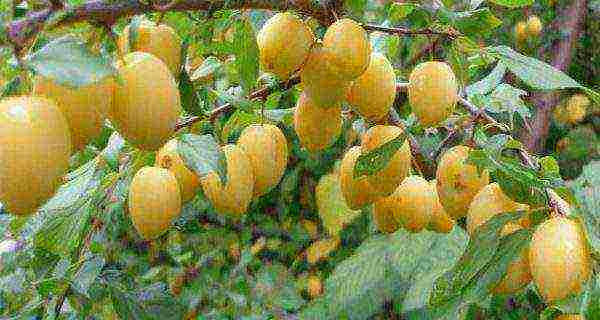 Plum Egg yellow
Plum Egg yellow
Yellow plum care
Caring for the yellow variety of plums is no different from caring for the blue. Some nuances depend on the specific variety, but the general rules are as follows:
- Regular watering. Plum loves water (but not stagnant water), and even drought-tolerant varieties will react to a long absence of watering with reduced yields.
- Regular feeding according to the scheme: in the spring - nitrogen, in the summer - full complex fertilizer, in the fall - phosphorus and potassium.
- Regular pruning. Plum quickly grows and "runs" upward, and it needs to be formed.
- The correct selection of pollinators for self-infertile varieties.
- If necessary, yield regulation (fruit thinning).
- Mandatory water charging for the winter (after leaf fall, before frost).
With proper care, yellow plums will provide the gardener with wonderful fruits and good mood for 15-20 years.
Plum varieties - fruits
In order to choose the right plum variety that is right for your area, you need to know the characteristics of each of them. Many take root well and bear fruit in all corners of Russia. Caring gardeners who decide to grow plums can enjoy ripe fruits all summer long, and in winter - prepared fragrant jam and marshmallow.
Plum varieties
Plum varieties are divided into three categories:
- early: July, Zarechnaya early, Skoroplodnaya;
- mid-season: Souvenir of the East, Romain;
- late: President, Empress.
Plum varieties - harvest
The varieties of yellow plum are also distinguished separately, the most popular of them are:
- Egg;
- Altai anniversary;
- Honey white.
Early ripening varieties
Such plums are especially prized for growing for sale, as they bring the maximum profit.
July
Plum varieties - july
The main characteristics are as follows:
- the first fruits ripen at the end of July;
- tree of medium size and density with arched shoots;
- the fruits are red and ovoid, weighing about 30 g;
- the pulp is yellow, sweet in taste;
- the yield from one tree reaches 12 kg;
- begins to bear fruit for 3 years.
Plum of the Yulskaya variety loves the sun and moderate soil moisture. They use it both fresh and preserved.
Zarechnaya early
Plum varieties - early trans-riverine
The early river plum has the following characteristics:
- ripens in mid-July;
- medium-sized tree with straighter branches;
- fruits are large, blue, have a waxy coating;
- the pulp is yellow, sourish in taste;
- regular yield, up to 15 kg of plums from a tree;
- bears fruit for 3-4 years.
This plum belongs to the table and technical consumption and has good taste.
Early
Plum varieties - fast-growing
A winter-hardy plum, it has the following characteristic qualities:
- ripening occurs in July-August;
- the crown of the tree is fan-shaped;
- fruits are small, up to 25 g, red;
- the pulp is juicy and aromatic;
- begins to bear fruit for 4 years;
- average yield - 10 kg per tree.
The life span of a fast-growing plum is up to 20 years. It is well transported and belongs to dessert varieties.
Mid-season varieties
The varieties ripening in the middle of summer are especially appreciated by gardeners, since they have the brightest and most intense aroma. It is from these fruits that the most delicious tinctures and jams are obtained.
Souvenir of the east
Plum varieties are a souvenir of the east. Harvested crop
Quite a popular variety of plum, bred by selectors. Main characteristics:
- grows not high, up to 2.5 m;
- plum fruits are large, beautiful, dark blue, weighing up to 40 g;
- the pulp is yellow, dense, crispy, sweet in taste;
- the yield indicator reaches 40 kg per tree.
An excellent table variety of plum with a high level of fruiting. It is used in the same way as the technical one.
Romain
Plum varieties - romaine
Plum Romaine has the following qualities:
- ripens in mid-August;
- leaves are reddish;
- the fruit is red, like the pulp;
- average fruit size (20-25 g), are of high quality.
This plum is great for growing in a summer cottage. Bears fruit regularly, is used both for food and for winter harvesting.
Late plum varieties
Used for harvesting and storing plums for the winter, often used for conservation. Most of the late varieties are frost-resistant and grow well in the northern strip of Russia.
The president
Late plum varieties - president
Plum President is universal in application. Character traits:
- ripening falls in the middle of September;
- large fruits, weighing up to 50 g, have a blue color with a waxy coating;
- the pulp is yellow, juicy;
- a middle-aged tree brings up to 40 kg of yield, an adult tree - up to 70 kg.
The fruits of the President plum are perfectly transported and stored for up to 2 weeks.They are used to make prunes. The tree is winter-hardy.
Empress
Late plum varieties - empress
The table variety of plum has the following qualities:
- tall tree, up to 4 m in height;
- the yield from one tree is up to 20 kg;
- bears fruit for 4-5 years;
- ripening of fruits falls in the second half of September;
- plum color is dark purple, average weight 45-50 g;
- the pulp is yellow, juicy.
This plum is used for juicing and preservation. Well transported.
Plum yellow varieties
Recently, gardeners prefer yellow ones when choosing plums. There is a misconception that this fruit should be blue, and the yellow varieties of plums are cherry plums. Not at all, they differ in both external and taste characteristics.
Egg
Plum yellow variety - Egg
Egg plum tolerates winter frosts and summer droughts well. Characteristic differences:
- average ripening period (August-September);
- fruits are large, round, weighing up to 50 g;
- quickly deteriorate, stored for less than a week, easily rot during the rainy season;
- bears fruit in the 6th year.
This type of plum is of medium quality and belongs to the technical one.
Altai anniversary
Plum yellow varieties - Altai Jubilee
It takes root well both in the northern and southern regions. Differs in the following qualities:
- early maturation;
- fruits are medium, round, weighing about 15 g;
- the color is yellow with red, has a white bloom;
- the pulp is loose and juicy;
- bears fruit in the 3rd year.
It is easily exposed to chlorosis and attacks of pests such as seed plants. Such a plum is not suitable for fresh transportation.
Honey white
Plum yellow varieties - Honey white
Yellow honey plum tastes like the product of the same name. Has the following characteristics:
- ripens early (mid-July);
- the height of the trees reaches 5 m;
- fruits are round, medium (up to 30 g);
- the pulp is juicy and sweet.
The honey plum is frost resistant and has a high yield.
How to choose the right plum sapling Plum varieties - Saplings
In order for the plum tree to begin bearing fruit on time and in the desired volume, it is necessary to take seriously the choice of good and healthy planting material.
Basic requirements for seedlings
It is customary to use plum seedlings for planting, the age of which does not exceed 2 years. In order to grow a large tree with a good crown in the future, sprouts with at least three branches in different directions and the main conductor (in the future, the trunk) are used.
Root length should be up to 40 cm with a good and clean root collar. The average thickness of a plum sapling is 2.5 cm.The length of the skeletal (main) branches reaches 50-60 cm.
Rules for the transportation and storage of seedlings
It is best to choose plum seedlings for planting with a closed root system, they are usually bought in autumn or spring. If the roots are not in the ground, they must be wrapped in a wet cloth or grass before transporting them, straw is also suitable. The resulting package is tied with twine. In this form, the seedlings can be transported. In no case should the roots dry out.
Outcome:
Plum has a huge number of varieties, so everyone can choose the one suitable for growing in their area and depending on taste preferences. If you purchase good planting material and follow the recommendations for care and planting, then the result will not be long in coming.
- Plum varieties for the Moscow region and the middle zone
- Early varieties of plums
- Self-fertile plum varieties
- Yellow plum varieties
- The largest varieties of plums
Plum varieties for the Moscow region and the middle zone
When choosing a variety of plums for planting in areas of the Moscow region and the middle lane, preference should be given to varieties with high frost resistance and resistance to diseases and pests. It is also advisable to choose varieties of plums with an early ripening period, so that the harvest has time to ripen before the autumn frosts.
"Rapid"
"Fast-growing" is one of the most popular varieties of plum for the Moscow region and central Russia, early ripening and fruitful. Self-infertile species. For cross-pollination, a hybrid cherry plum, "Red Ball", is suitable.
- Productivity 30 kg per tree.
- Reddish cream with yellow sweet flesh weighing 30 g.
- The tree is undersized about 2.5 m with a fan-shaped thin crown.
- The time for fruit ripening is the first half of August.
- The first harvest can be obtained already in the third year after planting the seedling.
- It tolerates severe frosts down to -40, suitable for growing in the Moscow region and the middle lane.
- It is slightly damaged by diseases and pests.
Advantages of the view: tasty fruits, drought-resistant, excellent frost resistance, early maturity
Minuses: self-infertility, poor separation of the bone from the pulp.
"Yakhontovaya"
"Yakhontovaya" is an early ripe fruitful type of plum, partially self-fertile. To obtain bountiful harvests in the neighborhood, varieties for cross-pollination are needed: "Skorospelka krasnaya", "Hungarian Moscow" or "Memory of Timiryazev".
- The harvest is 30 kg per tree.
- Yellow cream with a wax coating of 30-35 g with sweet and sour juicy pulp.
- The tree is of strong growth up to 5 m, the crown is neat spherical.
- Ripening of the crop by mid-August.
- Harvesting begins in the third or fourth year after planting.
- It tolerates frost perfectly, flower buds are resistant to spring frosts. The variety is zoned for the Moscow region and the middle zone.
- Satisfactory disease resistance.
Advantages of the view: early maturity, early ripening, frost resistance, easy separation of the bone from the pulp, fruits of excellent dessert taste.
Minuses: high tree height, partial self-fertility.
"Smolinka"
"Smolinka" is a precocious fruitful type of plum. Fruits of excellent taste are used fresh and for freezing, drying and preparation of prunes.
- Productivity 15-20 kg per tree.
- Dark purple cream weighing 35-40 g with sweet and sour tender pulp.
- Tall trees (5-5.5 m) with a thin crown.
- The harvest ripens in the second half of August.
- Plum begins to bear fruit in the fourth or fifth year of growth.
- Average winter hardiness, but sufficient for the conditions of the Moscow region and the middle zone. The branches quickly recover after freezing.
- With good care, resistance to major diseases is decent.
Advantages of the view: large fruits of high quality, good transportability.
Minuses: high growth of trees, self-fertile, branches without support can break under the weight of the fruit.
"Red ball"
"Red ball" with early ripening and excellent frost resistance. This variety is partially self-fertile; to obtain decent yields, pollinators are needed in the neighborhood, for example, "Skoroplodnaya" or hybrid cherry plum.
- Productivity 18 kg per tree. Red cream with a waxy coating weighing up to 40 g. The pulp is yellow, juicy, sweet and sour in taste.
- The tree is not tall (about 2.5 m) with a rounded drooping crown.
- The fruits ripen by mid-August.
- Fruiting begins in the third year after planting.
- It perfectly tolerates severe frosts, but does not like thaws, after which it can freeze slightly. Recommended for planting in the Moscow region and the middle lane.
- It is practically not damaged by clasterosporium, but protection is needed from other diseases.
Advantages of the view: large tasty fruits, undersized trees, early maturity, high frost resistance, good transportability.
Minuses: during early flowering, damage by spring frosts is possible, partial self-fertility.
Early varieties of plums
The ripening time for early-ripening plum varieties is from late July to mid-August.
"Zarechnaya early"
"Zarechnaya early" - early ripening, fruitful. The variety needs cross-pollination. The best neighbors for this purpose are Volzhskaya krasavitsa and Etude.
- The annual harvest is 15 kg per tree.
- Dark purple cream weighing 40-50 g with yellow juicy pulp of sweet taste.
- The tree is medium-sized with a compact crown.
- The fruits are ready to be harvested at the end of July.
- Plum begins to bear fruit in the fourth year after planting.
- Winter hardiness is high. The variety is zoned for the Central Black Earth region.
- Disease resistance is good.
Advantages: early ripe, large sweet plums, the stone is easily separated from the pulp, excellent frost resistance, good transportability
Minuses: self-infertility
"Oryol Dream"
"Orlovskaya Dream" is an early maturing, frost-resistant plum variety with partial self-fertility. The best neighbors for cross-pollination "Skoroplodnaya" or cherry plum.
- Average yields are 10-12 kg per tree.
- Red cream with subcutaneous specks, weight up to 40 g. The pulp is yellow, juicy, sweet and sour.
- The tree is not tall, 2.5-3 m with a pyramidal crown.
- Ripening time is the first half of August.
- Begins to bear fruit in the third year after planting the seedling.
- Frost resistance is excellent. Recommended for growing in the Central Black Earth Region.
- High resistance to clasterosporium disease.
Advantages: early ripening, frost-resistant, early-growing, the cream does not crack.
Minuses: self-fertility is partial, the stone is poorly separated, the fruits become smaller with an abundance of harvest.
"Indira"
"Indira" is a variety of domestic plum of the last generation, early maturing, fruitful, winter-hardy.
- Productivity 20-25 kg per tree.
- Blue cream weighing 35-45 g with yellow sweet pulp.
- A tree of strong growth with a dense pyramidal crown.
- Ripening period is early.
- Bears fruit in the fourth or fifth year of growth.
- Average winter hardiness (up to -35). The variety is zoned for the Middle Volga region.
Advantages of the view: early ripening, large tasty fruits, good yield.
Minuses: average winter hardiness.
"Sissy"
"Nezhenka" is an early maturing variety, partially self-fertile. Plum "Skoroplodnaya", "Red ball" and cherry plum varieties are suitable as pollinating neighbors.
- Average yield up to 15 kg.
- Red cream weighing 25-30 g. The pulp is yellowish, juicy, sweet and sour.
- Temperate tree (2.5-3 m) with a sparse crown.
- The ripening time of the crop is mid-August.
- Bears fruit in the fourth or fifth year of growth.
- Has a high winter hardiness, zoned in the Central Black Earth region.
- Disease resistance is relative.
Advantages: early maturing, the fruits do not crack, the stone separates well from the pulp, excellent winter hardiness.
Minuses: fruits when ripe quickly crumble, partial self-fertility.
"Candy"
"Candy" is remarkable for its very early ripening period. This type of domestic plum is self-fertile and needs pollinating neighbors. The best were "Early Zarechnaya" and "Collective Farm Renklod".
- Productivity 25 kg per tree.
- Cream red-burgundy with a bluish bloom weighing 30-35 g. The pulp is yellow, jelly, very sweet taste.
- A tree of short stature (2.5-3 m) with a compact crown.
- The fruits are ready to be harvested at the end of July.
- Begins to bear fruit in the fourth year of growth.
- Average frost resistance (up to -20). When grown in the Central regions, it is better to cover the trunk for the winter.
- Resistance to major diseases is good.
Advantages: large sweet plums, short trees, fast-growing, fruitful, the stone is well separated from the pulp.
Minuses: self-infertile species needs pollinating neighbors, low keeping quality and transportability.
Self-fertile varieties of plums
Self-fertile varieties of plums are able to pollinate with their own pollen and bring good yields. They do not need pollinating neighbors, but if they are present, the yield increases significantly.
"Memory of Timiryazev"
"Pamyat Timiryazev" is notable for its high self-fertility, but with prolonged severe frosts (below -30), the fruit buds freeze and the yield may noticeably decrease.
- Productivity 10-15 kg, in favorable conditions up to 35 kg.
- Yellow cream with a reddish blush weighing 20-25 g with sweet and sour dense pulp, the stone is easily separated.
- Ripening of the crop in late August - early September.
- The tree is undersized (up to 3 m) with a drooping, rounded crown.
- The first harvest begins to bring in the 4th year after the planting of the soot.
- Average winter hardiness, but when freezing, the branches quickly recover. It is safely grown in areas of the middle lane.
- Resistance to major diseases is satisfactory.
Advantages of the view: fast-growing, self-fertile, disease-resistant, productive, good transportability.
Minuses: average winter hardiness, severely damaged by plum mites.
"Viola"
Viola is characterized by high self-fertility, excellent and stable yield.
- The yield is 25-30 kg per tree.
- Blue cream weighing 20 g with sweet and sour juicy pulp.
- Harvest is ready for harvest in early September.
- The tree is spreading, medium-sized.
- The first fruits bears in the third or fourth year after disembarkation.
- Frost resistance at an average level. Recommended for growing in the Middle Volga region.
- It is slightly damaged by diseases and pests.
Advantages of the view: high self-fertility, abundant yields, fast-growing, good transportability of fruits.
Minuses: small size of fruits, in dry summers, plums may crumble, poor separation of the stone from the pulp.
"Morning"
"Morning" - has a high self-fertility, regularly brings good harvests. This variety is a good pollinator for many self-fertile forms of domestic plum.
- The harvest is 15 kg per tree.
- Yellowish-green cream with a pink barrel weighing 25 g with aromatic, tasty pulp. The bone is easily separated.
- Harvest is ready for harvest in early August.
- The tree is short with a crown of moderate density.
- The first fruits bears in the fourth or fifth year after planting the seedling.
- The frost resistance of the tree is average, and of the flower buds it is low. The variety is zoned for the Central region.
- Resistance to diseases and pests is satisfactory.
Advantages of the view: high self-fertility, early maturing, quickly recovering when freezing, good transportability.
Minuses: low frost resistance of flower buds.
"Peaceful"
"Mirnaya" is one of the self-fertile varieties of home plum.
- Productivity 25-40 kg per tree, annual yields, stable
- Burgundy-purple cream weighing 25-30 g with sweet and sour juicy pulp. The bone is separated well.
- The fruits reach ripeness in the first half of August.
- A tree of strong growth with an oval crown of moderate density.
- Begins fruiting in the fifth year after planting.
- Frost resistance is good enough. The variety is zoned for the Middle Volga and Lower Volga regions.
- Disease resistance is satisfactory.
Advantages: self-fertile, high-yielding, large tasty plums of universal use, good winter hardiness.
Minuses: ripening of fruits is non-simultaneous.
"Bogatyrskaya"
"Bogatyrskaya" is a self-fertile type of domestic plum, which gives very high yields from an early age.
- Yields are 50-60 kg, later up to 80 kg per tree
- Elongated, dark purple cream weighing 30-40 g with delicate sweet-sour pulp.
- The crop can be harvested in the second half of August.
- Begins fruiting in the fifth year after planting.
- Frost-resistant, zoned for the Lower Volga region.
- Disease and pest resistance is good enough.
Advantages of the view: self-fertile, high-yielding, large fruits with good transportability, high frost resistance.
Minuses: with abundant harvests, the branches may break and the fruits become smaller.
Yellow plum varieties
"Golden ball"
The "Golden Ball" is an early ripening type of yellow plum. The variety is self-fertile. The best pollinating neighbors "Skoroplodnaya" or hybrid cherry plum.
- The yield is 15 kg with a subsequent increase in the yield.
- Round cream, yellow with a pinkish blush, weighing 40-50 g. The pulp is fragrant, juicy, sweet with sourness near the stone.
- Ripening time - mid-August.
- Spreading tree with a height of 3-4 m.
- The first crop gives already in the third year after planting.
- Excellent winter hardiness. Zoned for the Central and Central Black Earth region.
- Satisfactory resistance to major plum diseases.
Advantages of the view: large sweet fruits, early maturing, early-ripening, good transportability.
Minuses: self-fertility, with abundant yields, plums become smaller, low drought resistance.
"Golden large"
"Golden large" - a type of yellow domestic plum with a high yield, late ripening. Partially self-fertile. The best pollinating neighbors are Volzhskaya krasavitsa and Mirnaya.
- Yield 27 kg per tree
- Yellow cream with a ruddy barrel weighing 40 g with sweet and sour tender pulp. The bone is easily separated.
- Fruits ripen in the first half of September.
- Medium-sized tree with a sparse pyramidal crown.
- In the fourth year after planting, the seedling gives the first harvest.
- Frost resistance is satisfactory. The variety is zoned for planting in the Lower Volga region.
- Practically immune to disease.
Advantages: fruitful, tasty large plums, good transportability, high disease resistance, drought tolerant.
Minuses: late ripening of fruits, partial self-fertility.
"Covenant"
"Covenant" is a kind of yellow Chinese plum. Self-infertile variety. For pollination, pollinating neighbors are needed: hybrid cherry plum or other types of Chinese plum.
- Productivity is stable about 30 kg per tree
- Round yellow cream with a pinkish barrel weighing 25-30 g. The pulp is juicy, dense, sweet-sour in taste.
- The plum ripens in early September.
- Sprawling tree up to 3 m tall.
- Fruiting begins in the fourth year of growth.
- Frost resistance is high. Zoned across the Volga-Vyatka region.
- Disease resistance is excellent. Can be damaged by plum aphid and sawfly.
Advantages of the view: abundant productivity, good quality fruits, high winter hardiness.
Minuses: self-infertility, can be damaged by pests.
"Honey white"
"Honey White" is an early ripening variety of plum. Needs cross-pollination. The best pollinating neighbors are "Vengerka Donetskaya", "Renklod Karbysheva".
- The yield is 35-40 kg per tree.
- Oval cream, yellow with an orange barrel weighing 35-50 g with aromatic sweet pulp. The bone is not separated well.
- The harvest ripens at the end of July.
- The tree is vigorous in height up to 5 m with a thin crown.
- Begins fruiting in the fourth year of growth. Has a high frost resistance. It is safely grown in the Central Black Earth Region and the Moscow Region
- Practically unaffected by moniliosis. Medium resistance to other diseases
Advantages: sweet large fruits, early ripening, high frost resistance and drought resistance.
Minuses: strong tree growth, self-fertility.
Large-fruited varieties of plums
"Giant"
"Giant" is a large-fruited variety of plum with a high yield, self-fertile.
- Productivity 40 kg.
- Cream red-pink weighing 60-80 g with sweet and sour juicy pulp. The bone is not separated well.
- The harvest ripens at the end of August.
- A tree of medium height up to 4 m with a dense crown.
- The first harvest gives in the third or fourth year.
- Average winter hardiness (up to -34). Suitable for planting in the Lower Volga region.
- It is affected by moniliosis. Preventive measures are needed for protection.
Advantages: very large fruits, good yield, early maturity.
Minuses: average winter hardiness, low drought resistance
"Angelina"
"Angelina" - a variety of plums with very large fruits, self-fertile. Suitable for pollination "Traveler", "Black Amber", "Friar".
- Yields are plentiful and amount to 50-70 kg per tree.
- Deep purple cream weighing 90 g with sweet and sour juicy pulp.
- Fruits ripen in the second half of September.
- Spreading tree with a height of 3 m.
- The first fruits appear in the third year after planting.
- Average winter hardiness. Suitable for cultivation in the southern regions.
- Disease resistance is average.
Advantages: fruits can be stored in a refrigerator without freezing for 2-3 months, plums are large for universal use, early maturity, high yield.
Minuses: average winter hardiness and disease resistance
"The president"
“President” is a large-fruited type of plum, self-fertile and fruitful.
- Productivity 20-40 kg with subsequent building up to 70 kg from a tree
- Oval cream, burgundy-purple, weighing 60-70 g, sweet taste.
- Plums ripen in the second half of September.
- The tree is spreading, thickened with a height of 3-3.5 m.
- Begins fruiting in the fifth year.
- Average winter hardiness (up to -30). The variety is adapted for the forest-steppe and steppe zones
- Average resistance to major diseases
Advantages of the view: large sweet fruits, high productivity, self-fertility, drought resistance
Minuses: dense and spreading crown requires formation and thinning, is damaged by plum aphid and moth, prone to gum flow
"Start"
"Starter" is a large-fruited variety, very early ripening, self-fertile. The pollinator can be a variety of home plum, which coincides in terms of flowering.
- Low yield 60 kg / ha.
- Round, burgundy-violet cream weighing 50-70 g. The pulp is juicy, sweet with sourness. The bone is easily separated from the pulp.
- The fruits ripen at the end of July.
- A medium-sized tree with a dense crown.
- Fruiting begins in the third or fourth year after planting the seedling.
- Good winter hardiness. Zoned for the Central Black Earth Region.
- High resistance to diseases and pests.
Advantages: large tasty fruits, good transportability, early ripening.
Minuses: self-fertile, low yield.
Save article to:
Dear visitors of the "Dacha Plot", tireless gardeners, gardeners and flower growers. We offer you to pass the aptitude test and find out whether you can trust the shovel and let you into the garden with it.
Test - "What kind of summer resident I am"
Share this article with your friends:

